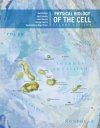Textbook
By: Rob Phillips(Author), Jane Kondev(Author), Julie Theriot(Author), Hernan G Garcia(Author), Nigel Orme(Illustrator)
1057 pages, 742 colour illustrations, 700 colour tables
![Physical Biology of the Cell Physical Biology of the Cell]()
Click to have a closer look
About this book
Contents
Customer reviews
Biography
Related titles
About this book
Physical Biology of the Cell is a textbook appropriate for a first course in physical biology or biophysics for either undergraduate or graduate students. It maps the huge and complex field of cell and molecular biology from the distinct perspective of physical biology. By organizing ideas and data based on proximity in physical biology space we can study topics that are not obviously related in cell biology space. This organizational principle is the central thesis of the book: the appropriate application of a relatively small number of fundamental physical models can serve as the foundation of whole bodies of quantitative biological intuition, broadly useful across a wide range of biological problems.
The much-anticipated full-color Second Edition includes new features and resources.
Contents
Part I: The Facts of Life
1. Why: Biology by the Numbers
2. What and Where
3. When: Stopwatches at Many Scales
4. Who: "Bless the Little Beasties"
Part II: Life at Rest
5. Mechanical and Chemical Equilibrium
6. Entropy Rules!
7. Two-State Systems
8. Random Walks and the Structure of Macromolecules
9. Electrostatics for Salty Solutions
10. Beam Theory
11. Biological Membranes
Part III: Life in Motion
12. The Mathematics of Water
13. A Statistical View of Biological Dynamics
14. Crowded and Disordered Environments
15. Rate Equations and Dynamics in the Cell
16. Dynamics of Molecular Motors
17. Biological Electricity
18. Light and Life
Part IV: The Meaning of Life
19. Organization of Biological Networks
20. Biological Patterns: Order in Space and Time
21. Sequences, Specificity, and Evolution
22. Whither Physical Biology?
Customer Reviews
Biography
Rob Phillips is in the Department of Applied Physics at the California Institute of Technology. He received a PhD in physics from Washington University in St. Louis. Jane Kondev is in the Department of Physics and the Graduate Program in Quantitative Biology at Brandeis University. He attended the Mathematical High School in Belgrade, Serbia, received his Physics BS degree from the University of Belgrade, and his PhD from Cornell University. Julie Theriot is in the Department of Biochemistry and the Department of Microbiology and Immunology at the Stanford University School of Medicine. She received concurrent BS degrees in Physics and Biology from the Massachusetts Institute of Technology, and a PhD in Cell Biology from the University of California at San Francisco. Hernan Garcia is an associate research fellow at Princeton University.
Textbook
By: Rob Phillips(Author), Jane Kondev(Author), Julie Theriot(Author), Hernan G Garcia(Author), Nigel Orme(Illustrator)
1057 pages, 742 colour illustrations, 700 colour tables
Reviews of the first edition:
"[The] authors of Physical Biology of the Cell have produced one of the first multi-purpose textbooks that is readily accessible to both physicists and biologists [...] When read from cover to cover, the book is both very instructive and highly entertaining, with the authors using humor to deliver strong take-home messages in each chapter [...] Physical Biology of the Cell provides instructors with excellent material to create a graduate level course in biology or physics. The book is also very timely as it presents the most recent views in cell biology."
– Nature Cell Biology, 2009
" [...] a monumental undertaking by three outstanding experts in the field [...] the book is a rich collection of special topics in biophysics [...] "
– Quarterly Review of Biology, 2009
"Physical Biology of the Cell is beautifully crafted: self-contained and modular, it provides tutorials on fundamentals and has material to hold the interest of a more sophisticated reader. It is fast-paced, proceeding within each chapter from freshman basics to graduate level sophistication. The book requires minimal prerequisites: a curious mind and undergraduate calculus will go a long way. It can be used as an undergraduate or early graduate biophysics course in a physics or engineering department. To truly master the physics presented in the book, one should do the problems provided with each chapter. These problems are well thought out and are a major teaching resource [...] Physical Biology of the Cell offers a great deal of flexibility as a teaching tool."
– Cell, 2009
"I would thoroughly recommend [Physical Biology of the Cell] to anyone interested in investigating or applying biophysical research methods to their work. It is likely to be a fantastic teaching tool and is a welcome addition in this age of increasingly interdisciplinary science."
– British Society for Cell Biology, 2009
"Physical Biology of the Cell [...] squarely addresses the issue of bringing the physics and biology communities closer together. Written by a very bright team of quantitative biologists, with training in both physics and biology, the book aims to be both an introduction to molecular and cellular biology for physicists and an introduction to physics for biologists. Though that sounds like a daunting task, the book fully and impressively delivers. Physical Biology of the Cell might well become a similar classic [as Molecular Biology of the Cell] for anyone who heeds its mantra "quantitative data demand quantitative models." It will give both physicists and biologists a useful introduction into the other camp's methods and ways of thinking. As a result, future generations of physicists and biologists can work together to attack the challenges of the life sciences in the twenty-first century."
– Physics Today, 2009

































